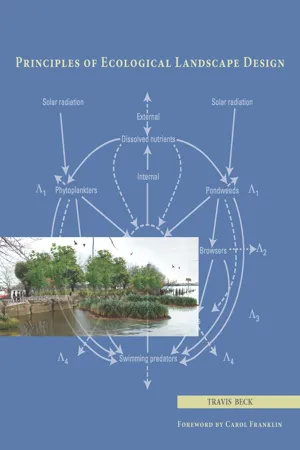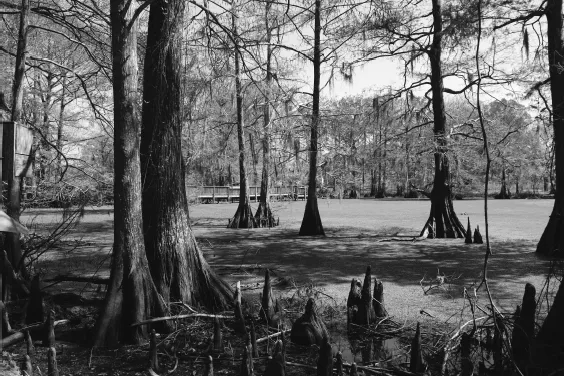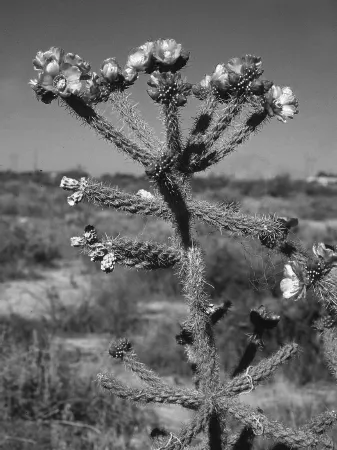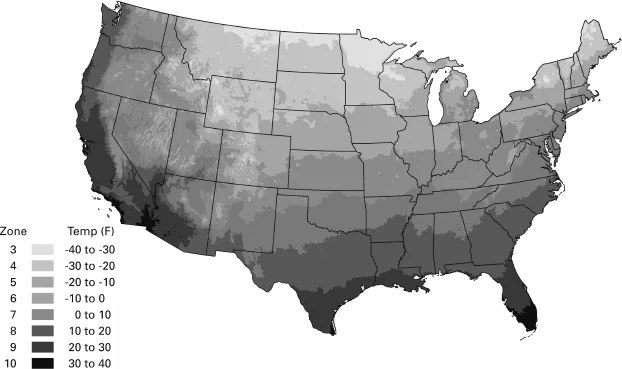
- English
- ePUB (mobile friendly)
- Available on iOS & Android
eBook - ePub
Principles of Ecological Landscape Design
About this book
Today, there is a growing demand for designed landscapes—from public parks to backyards—to be not only beautiful and functional, but also sustainable. With Principles of Ecological Landscape Design, Travis Beck gives professionals and students the first book to translate the science of ecology into design practice.
This groundbreaking work explains key ecological concepts and their application to the design and management of sustainable landscapes. It covers topics from biogeography and plant selection to global change. Beck draws on real world cases where professionals have put ecological principles to use in the built landscape.
For constructed landscapes to perform as we need them to, we must get their underlying ecology right. Principles of Ecological Landscape Design provides the tools to do just that.
Frequently asked questions
Yes, you can cancel anytime from the Subscription tab in your account settings on the Perlego website. Your subscription will stay active until the end of your current billing period. Learn how to cancel your subscription.
No, books cannot be downloaded as external files, such as PDFs, for use outside of Perlego. However, you can download books within the Perlego app for offline reading on mobile or tablet. Learn more here.
Perlego offers two plans: Essential and Complete
- Essential is ideal for learners and professionals who enjoy exploring a wide range of subjects. Access the Essential Library with 800,000+ trusted titles and best-sellers across business, personal growth, and the humanities. Includes unlimited reading time and Standard Read Aloud voice.
- Complete: Perfect for advanced learners and researchers needing full, unrestricted access. Unlock 1.4M+ books across hundreds of subjects, including academic and specialized titles. The Complete Plan also includes advanced features like Premium Read Aloud and Research Assistant.
We are an online textbook subscription service, where you can get access to an entire online library for less than the price of a single book per month. With over 1 million books across 1000+ topics, we’ve got you covered! Learn more here.
Look out for the read-aloud symbol on your next book to see if you can listen to it. The read-aloud tool reads text aloud for you, highlighting the text as it is being read. You can pause it, speed it up and slow it down. Learn more here.
Yes! You can use the Perlego app on both iOS or Android devices to read anytime, anywhere — even offline. Perfect for commutes or when you’re on the go.
Please note we cannot support devices running on iOS 13 and Android 7 or earlier. Learn more about using the app.
Please note we cannot support devices running on iOS 13 and Android 7 or earlier. Learn more about using the app.
Yes, you can access Principles of Ecological Landscape Design by Travis Beck in PDF and/or ePUB format, as well as other popular books in Architecture & Architecture General. We have over one million books available in our catalogue for you to explore.
Information
| 1. | Right Plant, Right Place: Biogeography and Plant Selection |
It is often said that the secret to good horticulture is putting the right plant in the right place. By matching plants to their intended environment, a designer helps to ensure that the plants will be healthy, grow well, and need a minimum of care. Too often designers force plants into the wrong places, putting large trees that thrive in extensive floodplains into confining tree pits or planting roses that need full sun in spindliness-inducing shade. Or we try to create a generically “perfect” garden environment, with rich soils and regular moisture, for a wide-ranging collection of plants, some of which may actually prefer more stringent conditions. Whether we do these things from ignorance, in conformance with established practices, or because our focus is on aesthetic qualities or our associations with certain plants, the too common result is struggling plantings, ongoing horticultural effort, and the dominance of familiar generalist species.
An ecological approach to landscape design takes the fundamental horticultural precept—right plant, right place—and views it through a biogeographical lens. Where do plants grow, and why do they grow there? How many degrees of native are there? What are the relative roles of environmental adaptation and historical accident? Selecting plants according to biogeographical principles can help us create designed landscapes that will thrive and sustain themselves. Such landscapes celebrate their region and fit coherently into the larger environment. Of course, these landscapes can also be beautiful. Let us begin, then, with a fundamental ecological question: Why is this plant growing here?
PLANTS ARE ADAPTED TO DIFFERENT ENVIRONMENTS
Five hundred million years ago the earth’s landmasses were devoid of life. Then, scientists speculate, ancestral relatives of today’s mosses began to grow along moist ocean margins and eventually on land itself. To survive out of water, these primitive plants had to evolve structures to support themselves out of water, ways to avoid drying out, and the ability to tolerate a broader range of temperatures. As they evolved, plants diversified and spread into every imaginable habitat, from deserts to wetlands, and from the tropics to the Arctic. Today, there are more than 300,000 plant species on our planet (May 2000).
Plant diversity and the diversity of habitats on Earth are closely related. Natural landscapes are composed of heterogeneous patches, each of which presents a different environment (see chap. 9). At the largest scale are deserts and rainforests. At the smallest scale are warm, sunny spots and wet depressions. Charles Darwin proposed in The Origin of Species (1859: 145),
The more diversified the descendants from any one species become in structure, constitution, and habits, by so much will they be better enabled to seize on many and widely diversified places in the polity of nature, and so be enabled to increase in numbers.
Plants have been able to move into so many different environments because they have developed many means of adapting. Consider plant adaptations to two critical environmental variables: temperature and the availability of water.
Temperature affects nearly all plant processes, including photosynthesis, respiration, transpiration, and growth. Very high temperatures can disrupt metabolism and denature proteins. Low temperatures can reduce photosynthesis and growth to perilously low levels and damage plant tissues as ice forms within and between cells. Plants that grow in high-temperature regions may have reflective leaves or leaves that orient themselves parallel to the sun’s rays in order to not build up heat. Some use the alternate C4 photosynthetic pathway, which can continue to operate efficiently at high temperatures. Plants in cold regions have developed bud dormancy and may grow slowly over several seasons before producing seed. They have high concentrations of soluble sugars in their cells to act as natural antifreeze, and they are able to accommodate intercellular ice without experiencing damage.
Plants that are adapted to grow well in wet, moist, and dry conditions are called, respectively, hydrophytes, mesophytes, and xerophytes. Hydrophytes have to provide oxygen to their flooded roots, which they do through a variety of mechanisms, including by developing spongy, air-filled tissue between the stems and the roots or by growing structures like knees that bring oxygen directly to the roots (fig. 1.1). Many hydrophytes also have narrow, flexible leaves to avoid damage from moving water. Xerophytes, on the other hand, exhibit adaptations to lack of water such as small leaves, deep roots, water storage in their tissues, and use of an alternate photosynthetic pathway that allows them to open the stomata on their leaves only in the cool of night (fig. 1.2).
Because of 500 million years of evolution and the diversity of habitats open to colonization, the planet is now filled with plants adapted to nearly every combination of environmental variables.
CHOOSE PLANTS THAT ARE ADAPTED TO THE LOCAL ENVIRONMENT
Because plants exhibit such a wide range of natural adaptations, we need not struggle—expending both limited resources and our collective energy—against the environment we find ourselves in to make it a better home for ill-suited plants. Using biogeography as our guide, we can always identify plants ready-made for the conditions at hand.
Gardeners, nursery owners, and landscape designers have long recognized that plants ill-suited to the temperature extremes of the place where they are planted are unlikely to survive their first year in the ground. The US Department of Agriculture has codified this knowledge in a map of hardiness zones, which was updated in 2012 (fig. 1.3). Hardiness zones represent the average annual minimum temperature, that is, the coldest temperature a plant in that zone could expect to experience. There are thirteen hardiness zones, ranging from zone one in the interior of Alaska (experiencing staggering winter minimums of below –50°F) to zone thirteen on Puerto Rico (experiencing winter minimums of barely 60°F). Plants are rated as to the lowest zone in which they can survive. Balsam fir (Abies balsamea), for instance, is hardy to zone three. The hardiest species of Bougainvillea are hardy only to zone nine. Plants are sometimes given a range (e.g., zones three to six). Strictly speaking, hardiness refers only to ability to survive minimum temperatures, but the practice of indicating a range serves as shorthand for the overall temperatures in which a plant will grow. The American Horticultural Society (2012) has also prepared a map of heat zones for the United States, indicating the number of days above 86°F that a region experiences on average per year. Catalog descriptions of landscape plants may include reference to these heat zones and to the more common hardiness zones.
Given the wide acceptance of hardiness zones, it is somewhat surprising that similar thinking applied to water requirements for plants has developed only within the past few decades. Perhaps this is because of the ease of meeting the needs of some plants for more water with irrigation. Or perhaps it is because of the deep influence of English gardening traditions in the United States and expectations of what a cultivated landscape should look like. Regardless of local conditions, our nationwide default residential landscape is water-hungry lawns and summer-flowering borders. Many regions of North America are in fact too dry, or receive precipitation too unevenly, to support this kind of designed landscape without major inputs of water. In San Diego, for example, more than half of all residential water is used to irrigate lawns and landscapes (Generoso 2002). Using water this way can deplete aquifers, damage habitat in areas from which water is drawn, decrease local agricultural production, and leave our landscapes vulnerable to desiccation when water restrictions go into effect.
The negative consequences of landscape irrigation and the countervailing benefits of water conservation motivated Denver Water (the water department in Denver, Colorado) to introduce xeriscaping in 1981. Xeriscaping, from the Greek word xeros, for “dry,” emphasizes grouping plants in the landscape according to their water needs (Weinstein 1999). Not surprisingly, many xeriscapes feature xerophytes, plants with low water needs.
Denver exists in a semiarid environment, getting on average around 14 inches of precipitation a year, as compared to about 35 to 40 inches a year in most areas east of the Mississippi. Kentucky bluegrass (Poa pratensis) lawns, shade trees, and most common garden plants need additional water to survive. At their former home, Panayoti and Gwen Kelaidis ambitiously replaced their entire front lawn with plants well adapted to Denver’s semiaridity. These include sulfur-flower buckwheat (Eriogonum umbellatum), soapweed (Yucca glauca), and partridge feather (Tanacetum densum ssp. amani). Today, 20 years later, these plants are still thriving with no supplemental irrigation (fig. 1.4).
Selecting plants that are adapted to the temperatures and available water of the environment in which they will be placed is a fundamental step in creating an ecological landscape.

Figure 1.1 Knees bring oxygen to the roots of some hydrophytes, such as these bald cypress (Taxodium distichum) growing in a swamp at the Lacassine National Wildlife Refuge in Louisiana. (Photo courtesy of the US Fish and Wildlife Service.)

Figure 1.2 Tree cholla (Cylindropuntia imbricata), a xerophyte native to the southwestern United States and northern Mexico, photosynthesizes with its stems, rather than with leaves, and stores water from periodic rainfall in succulent tissues protected with spines. (Photo by Gary Kramer, USDA Natural Resources Conservation Service.)

Figure 1.3 The 2012 USDA Plant Hardiness Zone Map. Note the fairly regular progression of zones from north to south in the center of the continent and the irregular zone boundaries related to mountain ranges and the moderating effects of large bodies of water (including the Great Lakes) in the west and east. (US Department of Agriculture.)
BIOMES DESCRIBE THE BOARD CHARACTER OF A REGION’S VEGETATION
In late July 1799, Alexander von Humboldt, a German naturalist traveling aboard a Spanish vessel with French botanist Aimé Bonpland, came to the bow for his first glimpse of the shore of South America (Humboldt and Bonpland 1818: 175–76). He wrote,
Our eyes were fixed on the groups of cocoa-trees that border the river, and the trunks of which, more than sixty feet high, towered over the landscape. The plain was covered with tufts of cassias, capers, and those arborescent mimosas, which, like the pine of Italy, extend their branches in the form of an umbrella. The pinnated leaves of the palms were conspicuous on the azure of a sky, the clearness of which was unsullied by any trace of vapors. The Sun was ascending rapidly toward the zenith. A dazzling light was spread through the air, along the whitish hills strewed with cylindric cactuses, and over a sea ever calm, the shores of which were peopled with alcatras, egrets, and flamingoes. The splendor of the day, the vivid coloring of the vegetable world, the forms of the plants, the varied plumage of the birds, everything announced the grand aspect of nature in the equinoctial regions.
For a couple of newly arrived Europeans, these were truly stunning sights. After 5 years of travel throughout Latin America, Humboldt (1805: 56) was able to organize some of his observations in an essay on what he called “the geography of plants,” a foundational work in the field we now know as biogeography:
Plant forms closer to the equator are generally more majestic and imposing; the veneer of leaves is more brilliant, the tissue of the parenchyma more lax and succulent. The tallest trees are constantly adorned by larger, more beautiful and odoriferous flowers than in temperate zones… . However the tropics never offer our eyes the green expanse of prairies bordering rivers in the countries of the north: one hardly ever has the gentle sensation of spring awakening vegetation. Nature, beneficial to all beings, has reserved for each region particular gifts. A tissue of fibers more or less lax, vegetable colors more or less brash depending on the chemical mixture of elements and the stimulating strength of solar rays: these are just some of the causes that give each zone of the globe’s vegetation its particular character.
What Humboldt recognized as the particular character of each zone of the globe’s vegetation we today call a biome. Biomes are large geographic areas dominated by certain types of plant and animal life: rainforests in the wet tropics, for example, or prairies in drier temperate zones. Although today human impacts, particularly agriculture and urbanization, have somewhat obscured the nature and extent of biomes, underlying climatological realities still inform what will grow where. In fact, a simple graph uniting temperature and precipitation shows us what conditions give rise to what biomes (fig. 1.5). Where there are high temperatures and high levels of precipitation, tropical rainforests grow, capturing the sun’s energy in the substantial biomass of large standing forests. At the opposite extreme, where temperature and precipitation are both low, we find arctic and alpine tundra full of slow-growing, diminutive plants. Thus, temperature and precipitation drive the adaptations of plants in each area and determine the character of the vegetation in different regions of the globe.
...
Table of contents
- Cover Page
- Title Page
- Copyright
- Dedication
- Contents
- Acknowledgments
- Foreword
- Introduction
- 1. Right Plant, Right Place: Biogeography and Plant Selection
- 2. Beyond Massing: Working with Plant Populations and Communities
- 3. The Struggle for Coexistence: On Competition and Assembling Tight Communities
- 4. Complex Creations: Designing and Managing Ecosystems
- 5. Maintaining the World as We Know It: Biodiversity for High-Functioning Landscapes
- 6. The Stuff of Life: Promoting Living Soils and Healthy Waters
- 7. The Birds and the Bees: Integrating Other Organisms
- 8. When Lightning Strikes: Counting on Disturbance, Planning for Succession
- 9. An Ever-Shifting Mosaic: Landscape Ecology Applied
- 10. No Time Like the Present: Creating Landscapes for an Era of Global Change
- Bibliography
- Index